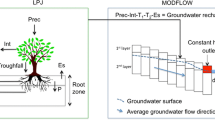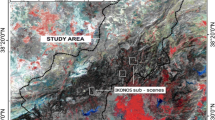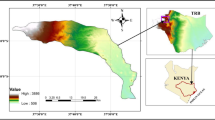Abstract
This study examines the effects of future climate changes on watershed hydroecology, including runoff, evapotranspiration, soil moisture content, gross primary production (GPP), and photosynthetic productivity (PSNnet), by applying the Regional Hydroecological Simulation System model to the Seolmacheon catchment (8.5 km2). Based on the daily runoff, evapotranspiration, and soil moisture content in the watershed from 2007 to 2009, calibration (2007–2008) and validation (2009) of the model were conducted. By utilizing PSNnet and GPP data collected with the Moderate Resolution Imaging Spectroradiometer sensor onboard the Terra satellite, model calibration (2007) and validation (2008) were implemented. For future climate change data, the MIROC3.2 (hires) and the HadCM3 climate change scenarios (A1B and B1), which were provided by the IPCC, were used for reference. Compared to the baseline period, the future temperature increased by a maximum of + 4.9 °C in the MIROC3.2 A1B scenario, and precipitation increased substantially in spring and winter. In the hydrological evaluation, MIROC3.2 showed annual change rates from − 33.9 to 6.0%. Both the A1B and B1 scenarios showed 6.0% and 1.0% increases in the 2020s and − 33.9% and − 32.8% decreases in the 2080s, respectively. For HadCM3, the A1B (B1) scenario showed rates of − 9.9% (1.4%), − 48.6% (− 19.2%), and − 42.4% (− 32.1%), in the 2020s, 2050s, and 2080s, respectively. Because climate region movement is relatively slow for temperature ranges when plant movement increases, existing forests might survive in their minimum state or vanish under extreme conditions, such as heat stress, droughts, and fires. In the simulation, the evapotranspiration volume, which was closely related to vegetation, caused the average annual temperature to increase by 2.6–3.6 °C, which caused local vegetation to vanish.







Similar content being viewed by others
References
Band LE, Patterson P, Nemani R, Running SW (1993) Forest ecosystem processes at the watershed scale: incorporating hillslope. Agric For Meteorol 63:93–126
Baron JS, Hartman MD, Kittel TGF, Band LE, Ojima DS, Lammers RB (1998) Effects of land cover, water redistribution, and temperature on ecosystem processes in the South Platte basin. Ecol Appl 8(4):1037–1051
Beven K, Kirkby M (1979) A physically-based variable contributing area model of basin hydrology. Hydrol Sci Bull 24:43–69
Cao M, Woodward FI (1998) Net primary and ecosystem production and carbon stocks of terrestrial ecosystem and their response to climate change. Glob Change Biol 4:185–198
Clapp R, Hornberger G (1978) Empirical equations for some soil hydraulic properties. Water Resour Res 14:601–604
Creed IF, Tague C, Swanson R, Rothwell RL (2000) The potential impacts of harvesting on the hydrologic dynamics of boreal watersheds. In: Proceedings of American Geophysical Union 2000 Spring Meeting, Washington, D.C., American Geophysical Union
Dan L, Ji J, Xie Z, Chen F, Wen G, Richey JE (2012) Hydrological projections of climate change scenarios over the 3H region of China: a VIC model assessment. J Geophys Res 117:D11102
Farquhar GD, von Caemmerer S (1982) Modeling photosynthetic response to environmental conditions. Encyclopedia of plant physiology. Physiological plant ecology II: water relations and carbon assimilation; encyclopedia of plant physiology. New Series 12B:549–587
Fredeen AL, Randerson JT, Holbrook NM, Field CB (1997) Elevated atmospheric CO2 increased water availability in a water-limited grassland ecosystem. J Am Water Resour Assoc 33:1033–1039
Heinsch FA, Reeves M, Votava P, Kang S, Milesl C, Zhao M, Glassy J, Jolly WM, Loehman R, Bowker CF, Kimball JS, Nemani RR, Running SW (2003) User’s guide, GPP and NPP(MOD 17A2/A3) products NASA MODIS land algorithm. The University of Montana, Missoula
Hwang TH, Kang SK, Kim YI, Kim J, Lee DW, Band LE (2008) Evaluating drought effect on MODIS gross primary production (GPP) with an eco-hydrological model in the Mountainous Forest, East Asia. Glob Change Biol 14(5):1037–1056
IPCC (2007) Climate change 2007: the physical science basis, contribution of working group 1 to the 4th assessment report of the intergovernmental panel on climate change. In: Salomon S, Qin D, Manning M, Chen Z, Marquis M, Averyt KB, Tignor M, Miller HL (eds) Cambridge University Press, Cambridge, United Kingdom
Ito A, Oikawa T (2000) A model analysis of the relationship between climate perturbations and carbon budget anomalies in global terrestrial ecosystems: 1970 to 1997. Clim Res 15(3):161–183
Jarvis P (1976) The interpretations of the variations in leaf water potential and stomatal conductance found in canopies in the field. Philos Trans R Soc Lond B273:593–610
Joh HK, Lee JW, Shin HJ, Park GA, Kim SJ (2010) Evaluation of evapotranspiration and soil moisture of SWAT simulation for mixed forest in the Seolmacheon catchment. Korean J Agric For Meteorol 12(4):289–297 (in Korean with English abstract)
Joh HK, Lee JW, Park M, Shin HJ, Yi JE, Kim GS, Srinivasan R, Kim SJ (2011) Assessing climate change impact on hydrological components of a small forest watershed through SWAT calibration of evapotranspiration and soil moisture. Trans ASABE 54(5):1773–1781
Kelliher FM, Leuning R, Raupach MR, Schulze ED (1995) Maximum conductances for evaporation from global vegetation types. Agric For Meteorol 73:1–16
Knapp AK, Hamerlynck EP, Ham JH, Owensby CE (1996) Responses in stomatal conductance to elevated CO2 in 12 grassland species that differ in growth form. Vegetatio 125:31–41
Korea Institute of Construction Technology (2008) Development of watershed Assessment techniques for healthy water cycle. Summary report, Korea Institute of Construction Technology, 2008–2039, pp 97–101. (in Korean)
Kwon HJ, Lee H, Lee YK, Lee JW, Jung SW, Kim J (2009) Seasonal variations of evapotranspiration observed in a mixed forest in the Seolmacheon catchment. Korean J Agric For Meteorol 11(1):39–47 (in Korean with English abstract)
Kӧrner C (1995) Leaf diffusive conductances in the major vegetation types of the globe. In: Schulze ED, Caldwell MM (eds) Ecophysiology of photosynthesis. Springer, New York, pp 463–490
López-Moreno JI, Zabalza J, Vicente-Serrano SM, Revuelto J, Gilaberte M, Azorin-Molina C, Morán-Tejeda E, García-Ruiz JM, Tague C (2014) Impact of climate and land use change on water availability and reservoir management: scenarios in the Upper Aragon River, Spanish Pyrenees. Sci Total Environ 493:1222–1231
Lüdeke M, Badeck F, Otto R (1994) The Frankfurt biosphere model: a global process oriented model of seasonal and long-term CO2 exchange between terrestrial ecosystems and the atmosphere. I. Model description and illustrative results for cold deciduous and boreal forests. Clim Res 4:143–166
Lutze JL, Gifford RM (1998) Carbon accumulation, distribution and water use of Danthonia richardsonii swards in response to CO2 and nitrogen supply over four years of growth. Glob Change Biol 4:851–861
Minville M, Brissette F, Krau S, Leonte R (2009) Adaptation to climate change in the management of a Canadian water-resources system exploited for hydropower. Water Resour Manag 23:2965–2986
Monteith JL (1965) Evaporation and environment. In: 19th symposia of the society for experimental. Biology, vol 19, pp. 205–234
Morgan JA, LeCain DR, Read JJ, Hunt HW, Knight WG (1998) Photosynthetic pathway and ontogeny affect water relations and the impact of CO2 on Bouteloua gracilis (C4) and Pascopyrum smithii (C3). Oecologia 114:483–493
Nash JE, Sutcliffe JV (1970) River flow forecasting through conceptual models, part I-A discussion of principles. J Hydrol 10:283–290
Nemani RR, Keeling CD, Hashimoto H, Jolly WM, Piper SC, Tucker CJ, Myneni RB, Running SW (2003) Climate-driven increases in global terrestrial net primary production from 1982 to 1999. Science 300:1560–1563
Park JS, Kim KT, Lee JH, Lee KS (2006) Applicability of multi-temporal MODIS images for drought assessment in South Korea. Korean Assoc Geogr Inf Stud 9(4):176–192 (in Korean with English abstract)
Park JY, Park GA, Kim SJ (2013) Assessment of future climate change impact on water quality of Chungju Lake, South Korea, Using WASP Coupled with SWAT. J Am Water Resour Assoc 49(6):1225–1238
Parton W, Mosier A, Ojima D, Valentine D, Schimel D, Weier K, Kulmala A (1996) Generalized model for N2 and N2O production from nitrification and denitrification. Global Biogeochem Cycles 10:401–412
Rawls WJ, Brakensiek DL, Saxton KE (1982) Estimation of soil water properties. Trans. ASAE 108:1316–1320
Running S, Coughlan J (1988) A general model of forest ecosystem processes regional applications, hydrologic balance, canopy gas exchange and photosynthesis. Can J For Res 17:472–478
Running S, Nemani R, Hungerfored R (1987) Extrapolation of synoptic meterological data in mountainous terrain and its use for simulating forest evapotranspiration and photosynthesis. Can J For Res 17:472–483
Running SW, Thornton PE, Nemani R, Glassy JM (2000) Global Terrestrial gross and net primary productivity from the earth observing system. In: Sala OE, Jackson RB, Mooney HA, Howarth RW (eds) Methods in ecosystem science, Springer, New York, pp 44–57
Running SW, Nemani RR, Heinsch FA, Zhao M, Reeves M, Hashimoto H (2004) A continuous satellite-derived measure of global terrestrial primary production. Bioscience 54(6):547–560
Schulze ED, Kelliher FM, Kӧrner C, Lloyd J, Leuning R (1994) Relationships among maximum stomatal conductance, ecosystem surface conductance, carbon assimilation rate and plant nitrogen nutrition: a global ecology scaling exercise. Annu Rev Ecol Syst 25:629–660
Shi X, Mao J, Thorton PE, Hoffman FO, Post WM (2011) The impact of climate CO2, nitrogen deposition and land use change on simulated contemporary global river flow. Geophys Res Lett 38(8):L08704
Shi X, Mao J, Thornton PE, Huang M (2013) Spatiotemporal patterns of evapotranspiration in response to multiple environmental factors simulated by the community land model. Environ Res Lett 8(024012):12
Shin HJ, Ha R, Park M, Kim SJ (2010) Estimation of Spatial Evapotranspiration using the Relationship between MODIS NDVI and Morton ET: For Chungjudam Watershed. J Korean Soc Agric Eng 52(1):19–24 (in Korean with English abstract)
Shin HJ, Park GA, Park M, Kim SJ (2012a) Projection of forest vegetation change by applying future climate change scenario MIROC3.2 A1B. Korean Assoc Geogr Inf Stud 15(1):64–75 (in Korean with English abstract)
Shin HJ, Park M, Kim SJ (2012b) Evaluation of forest watershed hydro-ecology using measured data and RHESSys model: For the Seolmacheon Catchment. J Korea Water Resour Assoc 45(12):1293–1307 (in Korean with English abstract)
Shin HJ, Park M, Hwang SJ, Park JY, Kim SJ (2014) Hydrologic impact of climate change with adaptation of vegetation community in a forest-dominant watershed. Paddy Water Environ 12(s1):s51–s63
Tague CL, Band LE (2001) Simulating the impact of road construction and forest harvesting on hydrologic response using rhessys. Earth Surf Process Landf 26:135–151
Tague CL, Band LE (2004) RHESSys: regional hydro-ecologic simulation system-an object oriented approach to spatially distributed modeling of carbon, water, and nutrient cycling. Earth Interact 8:1–42
Vertessy RA, Hatton TJ, Benyon RJ, Dawes WR (1996) Long term growth and water balance predictions for a mountain ash (Eucalyptus regnans) forest catchment subject to clear felling and regeneration. Tree Physiol 16:221–232
Volk M, Niklaus PA, Korner C (2000) Soil moisture effects determine CO2 responses of grassland species. Oecologia 125:380–388
Watson FGR, Pierce LL, Mulitsch M, Newman W, Nelson J, Rocha A (1999) Spatial modelling of the impacts of 150 years of land use change on the carbon, nitrogen, and water budgets of a large watershed. In: ESA annual meeting, 8th–12th August 1999, Spokane, USA
White MA, Thornton PE, Running SW, Nemani RR (2000) Parameterization and sensitivity analysis of the BIOME–BGC terrestrial ecosystem model: net primary production controls. Earth Interact 4(3):1–85
Yang D, Shao W, Yeh PJF, Yang H, Kanae S, Oki T (2009) Impact of vegetation coverage on regional water balance in the nonhumid regions of China. Water Resour Res 45:W00A14
Zierl B, Bugman H, Tague CL (2006) Water and carbon fluxes of European ecosystem: an evaluation of the ecohydrological model RHESSys. Hydrol Process 214(24):3328–3339
Acknowledgements
This work is supported by the Korea Agency for Infrastructure Technology Advancement (KAIA) Grant funded by the Ministry of Land, Infrastructure and Transport (Grant 18AWMP-B083066-05).
Author information
Authors and Affiliations
Corresponding author
Rights and permissions
About this article
Cite this article
Shin, H., Park, M., Lee, J. et al. Evaluation of the effects of climate change on forest watershed hydroecology using the RHESSys model: Seolmacheon catchment. Paddy Water Environ 17, 581–595 (2019). https://doi.org/10.1007/s10333-018-00683-1
Received:
Revised:
Accepted:
Published:
Issue Date:
DOI: https://doi.org/10.1007/s10333-018-00683-1




